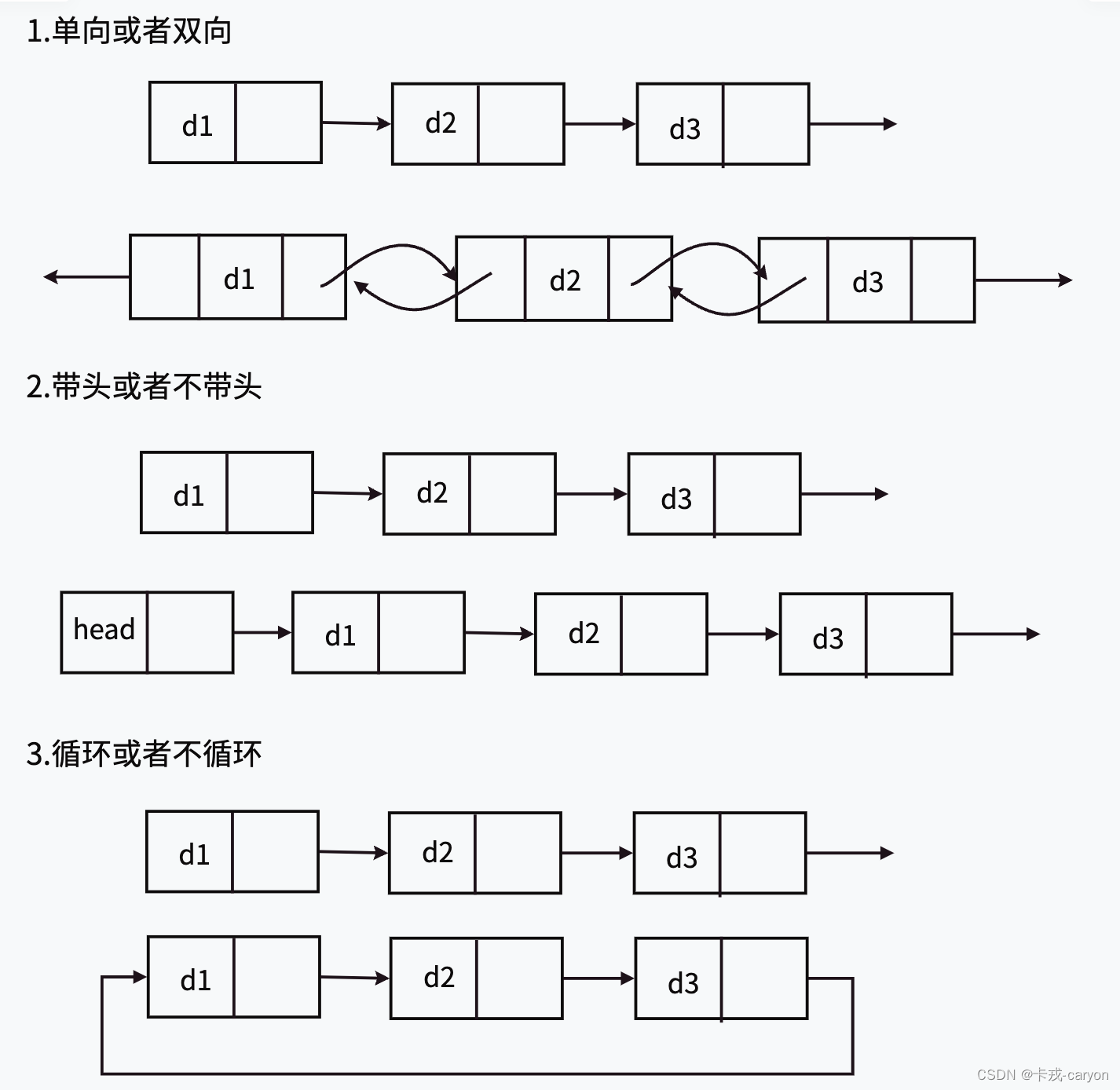一、链表的概念及结构
概念:链表是⼀种物理存储结构上非连续、非顺序的存储结构,数据元素的逻辑顺序是通过链表中的指针链接次序实现的。

节点的组成主要有两个部分:当前节点要保存的数据和保存下⼀个节点的地址(指针变量)。
补充说明:
1.链式机构在逻辑上是连续的,在物理结构上不⼀定连续
2、节点⼀般是从堆上申请的
3、从堆上申请来的空间,是按照⼀定策略分配出来的,每次申请的空间可能连续,可能不连续
二、单链表的实现
2.1节点的定义
typedef int SLDataType;
//定义链表结构体
typedef struct SList
{SLDataType data;//数据域struct SList* next;//指针域
}SL;
2.2单链表的打印
void SLPrint(SL** pphead)
{SL* cur = *pphead;while (cur){printf("%d->", cur->data);cur = cur->next;}printf("NULL\n");
}
2.3单链表的增删查改
这里由于申请结点使用较多,我们将其封装为一个函数。
//获得新节点
SL* SListBuynode(SLDataType x)
{SL* newnode = (SL*)malloc(sizeof(SL));if (newnode == NULL){perror("SListBuyNode is failed");return 1;}newnode->data = x;newnode->next = NULL;return newnode;
}
//尾插
void SLPushBack(SL** pphead, SLDataType x)
{assert(pphead);SL* newnode = SListBuynode(x);//链表没有元素时if (*pphead == NULL){*pphead = newnode;return;}//链表有元素时SL* tail = *pphead;while (tail->next){tail = tail->next;}tail->next = newnode;
}//尾删
void SLPopBack(SL** pphead)
{assert(*pphead);assert(pphead);//删除的时头结点if ((*pphead)->next==NULL){free(*pphead);*pphead = NULL;return;}//删除的不是头结点SL* cur_tail = *pphead;SL* cur = NULL;while (cur_tail->next){cur = cur_tail;cur_tail = cur_tail->next;}cur->next = NULL;free(cur_tail);cur_tail = NULL;
}//头插
void SLPushFront(SL** pphead, SLDataType x)
{assert(pphead);SL* newnode = SListBuynode(x);newnode->next = *pphead;*pphead = newnode;
}//头删
void SLPopFront(SL** pphead)
{assert(pphead);assert(*pphead);SL* cur_head = (*pphead)->next;free(*pphead);*pphead = cur_head;
}//查找
SL* SLFind(SL** pphead, SLDataType x)
{assert(pphead);SL* cur = *pphead;while (cur){if (cur->data == x){return cur;}cur = cur->next;}return NULL;
}//任意位置之前插入
void SLInsert(SL** pphead, SL* pos, SLDataType x)
{assert(pphead);assert(*pphead);assert(pos);SL* newnode = SListBuynode(x);//pos是头结点if (*pphead == pos){newnode->next = *pphead;*pphead = newnode;return;}//pos不是头结点 SL* cur = *pphead;while (cur->next != pos){cur = cur->next;}newnode->next =pos;cur->next = newnode;
}//指定位置之后插入
void SLInsertAfter(SL* pos, SLDataType x)
{assert(pos);SL* newnode = SListBuynode(x);newnode->next = pos->next;pos->next = newnode;
}//任意位置删除
void SLErase(SL** pphead, SL* pos)
{assert(pphead);assert(*pphead);assert(pos);//pos是头结点if (*pphead == pos){SL* newhead = (*pphead)->next;free(*pphead);*pphead = NULL;*pphead = newhead;return;}//pos不是头结点SL* cur = *pphead;while (cur->next != pos){cur = cur->next;}cur->next = pos->next;free(pos);pos = NULL;
}//删除指定位置之后的元素
void SLEraseAfter(SL* pos)
{assert(pos);assert(pos->next);SL* cur = pos->next;pos->next = cur->next;free(cur);cur = NULL;}
2.4单链表的销毁
//销毁链表
void SLDestroy(SL** pphead)
{SL* cur = *pphead;while (cur){SL* next = cur->next;free(cur);cur = next;}*pphead = NULL;
}
2.5 单链表的源代码
//SingleList.h
#pragma once#include<stdio.h>
#include<stdlib.h>
#include<assert.h>typedef int SLDataType;typedef struct SList
{SLDataType data;struct SList* next;
}SL;void SLPrint(SL** pphead);//打印void SLPushBack(SL** pphead, SLDataType x);//尾插
void SLPopBack(SL** pphead);//尾删void SLPushFront(SL** pphead, SLDataType x);//头插
void SLPopFront(SL** pphead);//头删void SLInsert(SL** pphead, SL* pos, SLDataType x);//指定位置之前插入
void SLInsertAfter( SL* pos, SLDataType x);//指定位置之后插入SL* SLFind(SL** pphead, SLDataType x);//查找void SLErase(SL** pphead, SL* pos);//指定位置元素删除
void SLEraseAfter(SL* pos);//删除指定位置之后的元素 void SLDestroy(SL** pphead);//销毁链表
//SingleList.c#define _CRT_SECURE_NO_WARNINGS #include"SL.h"void SLPrint(SL** pphead)
{SL* cur = *pphead;while (cur){printf("%d->", cur->data);cur = cur->next;}printf("NULL\n");
}SL* SListBuynode(SLDataType x)//获得新节点
{SL* newnode = (SL*)malloc(sizeof(SL));if (newnode == NULL){perror("SListBuyNode is failed");return 1;}newnode->data = x;newnode->next = NULL;return newnode;
}void SLPushBack(SL** pphead, SLDataType x)//尾插
{assert(pphead);SL* newnode = SListBuynode(x);if (*pphead == NULL){*pphead = newnode;return;}SL* tail = *pphead;while (tail->next){tail = tail->next;}tail->next = newnode;
}void SLPopBack(SL** pphead)//尾删
{assert(*pphead);assert(pphead);if ((*pphead)->next==NULL){free(*pphead);*pphead = NULL;return;}SL* cur_tail = *pphead;SL* cur = NULL;while (cur_tail->next){cur = cur_tail;cur_tail = cur_tail->next;}cur->next = NULL;free(cur_tail);cur_tail = NULL;
}void SLPushFront(SL** pphead, SLDataType x)//头插
{assert(pphead);SL* newnode = SListBuynode(x);newnode->next = *pphead;*pphead = newnode;
}void SLPopFront(SL** pphead)//头删
{assert(pphead);assert(*pphead);SL* cur_head = (*pphead)->next;free(*pphead);*pphead = cur_head;
}SL* SLFind(SL** pphead, SLDataType x)//查找
{assert(pphead);SL* cur = *pphead;while (cur){if (cur->data == x){return cur;}cur = cur->next;}return NULL;
}void SLInsert(SL** pphead, SL* pos, SLDataType x)//任意位置插入
{assert(pphead);assert(*pphead);assert(pos);SL* newnode = SListBuynode(x);if (*pphead == pos)//pos是头结点{newnode->next = *pphead;*pphead = newnode;return;}//pos不是头结点 SL* cur = *pphead;while (cur->next != pos){cur = cur->next;}newnode->next =pos;cur->next = newnode;
}void SLInsertAfter(SL* pos, SLDataType x)//指定位置之后插入
{assert(pos);SL* newnode = SListBuynode(x);newnode->next = pos->next;pos->next = newnode;
}void SLErase(SL** pphead, SL* pos)//任意位置删除
{assert(pphead);assert(*pphead);assert(pos);//pos是头结点if (*pphead == pos){SL* newhead = (*pphead)->next;free(*pphead);*pphead = NULL;*pphead = newhead;return;}//pos不是头结点SL* cur = *pphead;while (cur->next != pos){cur = cur->next;}cur->next = pos->next;free(pos);pos = NULL;
}void SLEraseAfter(SL* pos)//删除指定位置之后的元素
{assert(pos);assert(pos->next);SL* cur = pos->next;pos->next = cur->next;free(cur);cur = NULL;}void SLDestroy(SL** pphead)//销毁链表
{SL* cur = *pphead;while (cur){SL* next = cur->next;free(cur);cur = NULL;cur = next;}*pphead = NULL;
}
三、链表的分类
链表的结构非常多样,以下情况组合起来就有8种(2x2x2)链表结构:


虽然有这么多的链表的结构,但是我们实际中最常用还是两种结构:单链表和双向带头循环链表
- 无头单向非循环链表:结构简单,⼀般不会单独用来存数据。实际中更多是作为其他数据结构的子结构,如哈希桶、图的邻接表等等。
- 带头双向循环链表:结构最复杂,⼀般用在单独存储数据。实际中使用的链表数据结构,都是带头双向循环链表。另外这个结构虽然结构复杂,但是使用代码实现以后会发现结构会带来很多优势,实现反而简单了,后面我们代码实现了就知道了。














)
)



